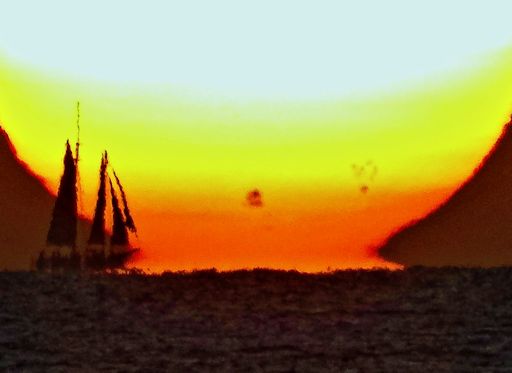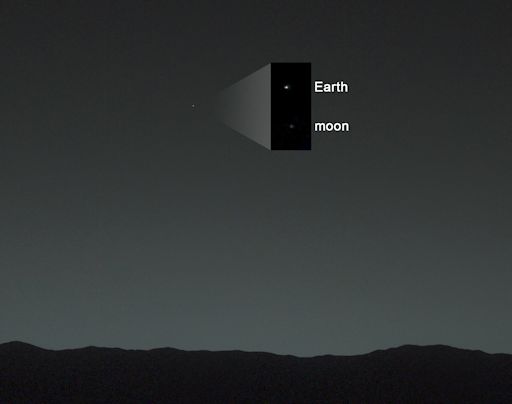WEEKEND STORM WARNING: Polar geomagnetic storms are possible on Saturday, Feb. 8th, when a solar wind stream and a minor CME are expected to hit Earth's magnetic field. This will not be a major storm, but the double-impact could spark high-latitude auroras. Aurora alerts: text, voice
BIG SUNSPOTS: All week long, big sunspot AR1967 has has been crackling with activity, seemingly on the edge of producing an X-class solar flare. That hasn't happened. However, a new sunspot growing alongside AR1967 could push things over the edge. Emerging active region AR1968 has an unstable 'beta-gamma-delta' magnetic field that harbors energy for strong explosions. NOAA forecasters estimate an 60% chance of M-class solar flares and a 20% chance of X-class solar flares on Feb. 7th. Solar flare alerts: text, voice
Last night in Key West, Florida, Scott Wilson looked out over the Gulf of Mexico and saw the two big sunspots melting into the sea:
The strange shape of the sun in Wilson's picture is a mirage caused by refraction in warm air just above the sea surface. There are many types of sunset mirages. This one is called the "Omega Sun" because the sun resembles the Greek letter omega.
Browse the gallery for more sunspot sunsets:
Realtime Space Weather Photo Gallery
CURIOSITY PHOTOGRAPHS EARTH: Last year when the Cassini spacecraft photographed Earth through the rings of Saturn, the whole world was alerted to smile and wave. Last week, Curiosity did the same thing with less fanfare. Except for a few scientists, no one knew the Mars rover would be taking this picture of the Earth-Moon system on Jan. 31st:
Mission controllers used the left eye of Curiosity's Mast Camera (Mastcam) to capture the scene about 80 minutes after local sunset in the Dingo Gap. Our planet was the brightest thing in the darkening Martian sky. A human observer with normal vision, if standing on Mars, would have easily seen Earth and the Moon as two distinct "evening stars." The distance to Earth when Curiosity took the photo was about 99 million miles. For more information about Curiosity's adventures on Mars, visit mars.jpl.nasa.gov.

Solar wind
speed: 404.1 km/sec
density: 4.8 protons/cm3
explanation | more data
Updated: Today at 1646 UT
X-ray Solar Flares
6-hr max: M1 1029 UT Feb07
24-hr: M2 0456 UT Feb07
explanation | more data
Updated: Today at: 1600 UT
![]()
Daily Sun: 07 Feb 14
Growing sunspot AR1968 has developed a 'beta-gamma-delta' magnetic field that harbors energy for X-class solar flares. Credit: SDO/HMI
![]()
Sunspot number: 223
What is the sunspot number?
Updated 07 Feb 2014
Spotless Days
Current Stretch: 0 days
2014 total: 0 days (0%)
2013 total: 0 days (0%)
2012 total: 0 days (0%)
2011 total: 2 days (<1%)
2010 total: 51 days (14%)
2009 total: 260 days (71%)
Update 07 Feb 2014
The Radio Sun
10.7 cm flux: 191 sfu
explanation | more data
Updated 07 Feb 2014
![]()
Current Auroral Oval:
Switch to: Europe, USA, New Zealand, Antarctica
Credit: NOAA/POES
![]()
Planetary K-index
Now: Kp= 1 quiet
24-hr max: Kp= 2 quiet
explanation | more data
Interplanetary Mag. Field
Btotal: 12.5 nT
Bz: 0.5 nT south
explanation | more data
Updated: Today at 1646 UT
![]()
Coronal Holes: 07 Feb 14
A solar wind stream flowing from the indicated coronal hole should reach Earth on Feb. 8-10. Credit: SDO/AIA.






